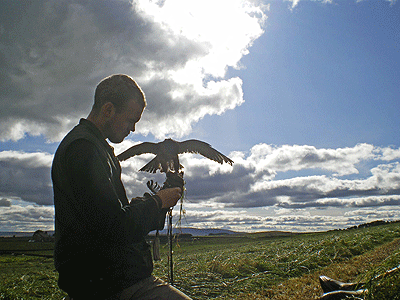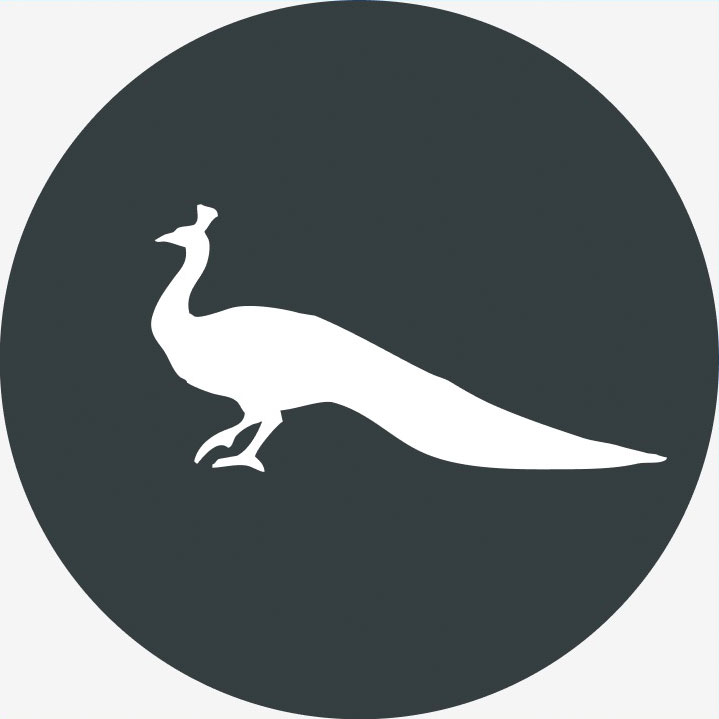Hawking with the Northumberland Crow Falcons
Octavia has an exhilarating day with the Northumberland Crow Falcons

Think of falconry, and you might imagine a swollen Henry VIII self-importantly bearing a hawk on a cloth-of-gold gauntlet, or perhaps a white-robed Arab flying an regal bird across miles of rolling sand. Yet the sport that in England in Elizabethan times boasted more participants than there are football fans today is burgeoning. Back in July, the popularity of hawking was brought home to me by the Falconry Festival at Englefield in Berkshire-I was overwhelmed by the extraordinary variety of costumes and birds of prey from all over the world. There were eagles from the Middle East, sparrowhawks from Eastern Europe, and, from Britain, peregrine/saker crosses borne by Dr Nick Fox of the Northumberland Crow Falcons (NCF).
Resplendent in the dark green livery worn by the original founders of the British Falconers Club in 1770, he is a world authority on falconry, and began the NCF in 1991. A few emails and telephone calls later, and I found myself cantering across the moors on a chestnut Arab mare called Danceaway.

The NCF hawk on horseback and on foot from cars in August and September, catching crows with falcons. On mounted days, Nick rides ahead with the falcon and two members to open gates and spot for crows. It's almost like stalking, creeping up on the crows-the foxes of the air-keeping a distance until one is close enough, then removing the falcon's hood and allowing it to see the crow. Once the bird has locked onto its quarry, it will swoop after it, flying fast and surely, sometimes almost out of sight into the sky. If there is no cover around, the crow may fly higher and higher in ascending circles, mirrored by the falcon, in the classical haute volee or high flight, up and up until the crow plunges straight and fast as an arrow, followed by the falcon.
If there is any kind of cover, the crow will fly straight to it, and if there are other crows around, they will work together to confuse the falcon and escape. These black-liveried corvids are incredibly clever, and to watch them literally fly rings around their enemy is an astonishing sight. They will use anything as cover-even swooping below cows at the last minute to escape. The falcons used are mainly peregrine/saker crosses, the peregrine blood giving them speed and stamina and the saker adding determination. If the falcon is successful, it will tuck in to its prey on the ground and spread its wings as a mantle to protect its meal from potential challengers. The falcons all have radio transmitters clipped to their feathers in case they go out of sight-a necessity given the likelihood of the chase lasting some miles.
On my day, under a completely cloudless sky, two young falcons, Tamsin and Becky, made excellent kills. Keeping one eye on the birds and one on the ground-avoiding bogs and rocks requires an element of care when proceeding at speed-galloping to keep up with Nick and simultaneously work out where the birds are going, was wonderfully exhilarating.
The NCF hawk on horseback and on foot from cars in August and September, catching crows with falcons. On mounted days, Nick rides ahead with the falcon and two members to open gates and spot for crows. It's almost like stalking, creeping up on the crows-the foxes of the air-keeping a distance until one is close enough, then removing the falcon's hood and allowing it to see the crow. Once the bird has locked onto its quarry, it will swoop after it, flying fast and surely, sometimes almost out of sight into the sky. If there is no cover around, the crow may fly higher and higher in ascending circles, mirrored by the falcon, in the classical haute volee or high flight, up and up until the crow plunges straight and fast as an arrow, followed by the falcon.
If there is any kind of cover, the crow will fly straight to it, and if there are other crows around, they will work together to confuse the falcon and escape. These black-liveried corvids are incredibly clever, and to watch them literally fly rings around their enemy is an astonishing sight. They will use anything as cover-even swooping below cows at the last minute to escape. The falcons used are mainly peregrine/saker crosses, the peregrine blood giving them speed and stamina and the saker adding determination. If the falcon is successful, it will tuck in to its prey on the ground and spread its wings as a mantle to protect its meal from potential challengers. The falcons all have radio transmitters clipped to their feathers in case they go out of sight-a necessity given the likelihood of the chase lasting some miles.
Exquisite houses, the beauty of Nature, and how to get the most from your life, straight to your inbox.
On my day, under a completely cloudless sky, two young falcons, Tamsin and Becky, made excellent kills. Keeping one eye on the birds and one on the ground-avoiding bogs and rocks requires an element of care when proceeding at speed-galloping to keep up with Nick and simultaneously work out where the birds are going, was wonderfully exhilarating.
And when all the excitement gets a bit much, everyone stops for afternoon tea. A suitable spot is found, in our case an emerald field above a lake with an islet in the centre that reminded me of Wildcat Island in Swallows and Amazons, the back of the hawking van is let down and everyone feasts on tea and sandwiches and cake. The NCF is a small and enormously friendly group, with only about six-10 mounted, and about as many again of car followers. Nick's wife Barbro acts as a kind of field master, but there are so few people that everyone is thoroughly involved-spotting crows, opening gates, keeping an eye on the flight-which adds a thrilling sense of worth and purpose to the whole thing.
On the Sunday, five of us set off again in the hawking van, to scour the lanes and moorland tracks for suitable quarry. We saw more tremendous flights, culminating with a superb battle above a farmhouse that ended in Becky killing under the trees-her Saker determination shining through. Sitting there in the sun-dappled woods as she enjoyed her reward, I reflected that such a scene had changed little in centuries. The walkers tramping along Hadrian's Wall only a few hundred yards away, completely oblivious to the drama that had just unfolded, may have thought they were experiencing the past whereas this ancient landscape, over which marauding Scots poured and English raiders charged, we and our kings of the skies were supreme.
Country Life is unlike any other magazine: the only glossy weekly on the newsstand and the only magazine that has been guest-edited by His Majesty The King not once, but twice. It is a celebration of modern rural life and all its diverse joys and pleasures — that was first published in Queen Victoria's Diamond Jubilee year. Our eclectic mixture of witty and informative content — from the most up-to-date property news and commentary and a coveted glimpse inside some of the UK's best houses and gardens, to gardening, the arts and interior design, written by experts in their field — still cannot be found in print or online, anywhere else.
